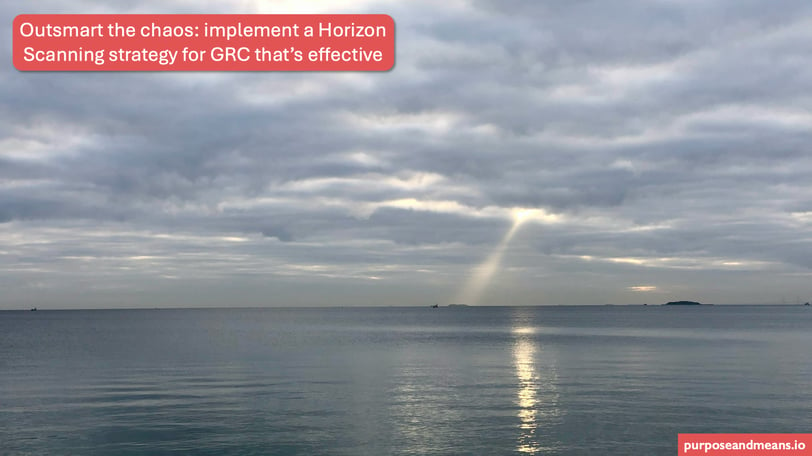Beginner's guide to Horizon Scanning in GRC
Start your GRC horizon scanning process. This guide covers the basics, key areas to watch, and initial steps to take.
DATA PROTECTION LEADERSHIPHORIZON SCANNING
Tim Clements
3/31/20254 min read


During these uncertain times, companies face a constant barrage of new risks and opportunities. Regulatory changes, technological advancements, and geopolitical shifts can all have a significant impact on a company's ability to achieve its objectives. To navigate this complex environment effectively, companies need to proactively identify and assess emerging trends and potential threats. This is where horizon scanning comes in.
What is Horizon Scanning in GRC?
Horizon scanning, in the context of Governance, Risk Management, and Compliance (GRC), is a systematic process of gathering and analysing information about potential future developments that could impact a company. It's about looking beyond the immediate horizon to identify emerging trends, potential risks, and opportunities that may not yet be fully apparent. Think of it as an early warning system for your GRC programme.
Unlike traditional risk assessments, which typically focus on known risks and historical data, horizon scanning takes a forward-looking approach. It aims to identify "weak signals" – early indicators of potential future developments – and to assess their potential impact on the company. This proactive approach allows companies to anticipate change, adapt their strategies, and mitigate potential risks before they materialise.
Why is Horizon Scanning Important?
In an increasingly complex and dynamic world, horizon scanning is no longer a "nice-to-have" but a necessity for effective GRC. Here’s why:
Proactive Risk Management: Horizon scanning enables companies to identify and address potential risks before they become major problems. This allows for more effective risk mitigation and reduces the likelihood of costly disruptions or compliance failures.
Strategic Advantage: By identifying emerging trends and opportunities early, companies can gain a competitive advantage. They can adapt their strategies, develop new products and services, and capitalise on new market opportunities before their competitors.
Improved Decision-Making: Horizon scanning provides valuable insights that can inform strategic decision-making. By understanding the potential future implications of different choices, companies can make more informed and effective decisions.
Enhanced Resilience: Horizon scanning helps companies to build resilience by anticipating and preparing for potential disruptions. This allows them to adapt quickly to changing circumstances and minimise the impact of adverse events.
Compliance Assurance: By monitoring regulatory changes and emerging compliance requirements, horizon scanning helps companies to stay ahead of the curve and ensure ongoing compliance. This reduces the risk of fines, penalties, and reputational damage.
Key Areas to Monitor
Effective horizon scanning requires monitoring a wide range of areas, including:
Regulatory Landscape: Keep a close watch on changes to laws, regulations, and industry standards that could impact your company. This includes monitoring regulatory bodies, tracking legislative developments, and engaging with industry associations.
Technological Advancements: Monitor emerging technologies and their potential impact on your business. This includes AI, blockchain, cloud computing, and other disruptive technologies. Consider how these technologies could create new risks or opportunities for your company.
Geopolitical Developments: Pay attention to global political and economic trends that could affect your organisation. This includes monitoring political instability, trade disputes, and other geopolitical risks.
Social and Environmental Trends: Monitor changing social attitudes and environmental concerns that could impact your company's reputation or operations. This includes issues such as climate change, social inequality, and data protection.
Competitive Landscape: Keep an eye on your competitors and their strategies. This includes monitoring their product development, marketing campaigns, and expansion plans.
Tools and Techniques for Beginners
Getting started with horizon scanning doesn't require sophisticated tools or techniques. Here are some simple approaches that beginners can use:
News Monitoring: Set up alerts for relevant keywords and topics using news aggregators, search engines, and social media monitoring tools.
Industry Publications: Subscribe to industry newsletters, journals, and blogs to stay informed about emerging trends and developments.
Professional Networks: Engage with industry peers, experts, and thought leaders through professional networks and online communities.
Webinars and Conferences: Attend industry webinars and conferences to learn about the latest trends and best practices.
SWOT Analysis: Use SWOT analysis to identify potential future opportunities and threats.
Scenario Planning: Develop different scenarios for the future and assess their potential impact on your organisation.
Setting Up a Basic Horizon Scanning Process
Here's a step-by-step guide to setting up a basic horizon scanning process:
Define Scope: Determine the key areas that you want to monitor. Focus on areas that are most relevant to your company's goals and objectives.
Identify Information Sources: Identify the sources of information that you will use to monitor these areas. This could include news sources, industry publications, professional networks, and internal data.
Collect Data: Collect data from your chosen information sources on a regular basis. Use automated tools to streamline the data collection process.
Analyse Data: Analyse the data to identify emerging trends, potential risks, and opportunities. Look for "weak signals" – early indicators of potential future developments.
Assess Impact: Assess the potential impact of these trends, risks, and opportunities on your organisation. Consider the likelihood and severity of each potential impact.
Communicate Findings: Communicate your findings to relevant stakeholders within your company. Share your insights with decision-makers and those responsible for risk management and strategic planning.
Take Action: Develop and implement strategies to mitigate potential risks and capitalise on emerging opportunities.
Looking for Guidance and Assistance?
Horizon scanning can be a complex and challenging process. If you're looking for guidance and support, Purpose and Means offers comprehensive horizon scanning and analysis services to help companies like yours stay ahead of the curve. Visit our service page about horizon scanning to learn more.
Also, feel free to get in touch to arrange a no obligation call to discuss your horizon scanning needs.
Purpose and Means
Purpose and Means believes the business world is better when companies establish trust through impeccable governance.
BaseD in Copenhagen, OPerating Globally
tc@purposeandmeans.io
+45 6113 6106
© 2025. All rights reserved.
